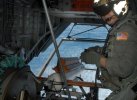I think a lot of folks are nuking this one a bit. The whole "everyone else jumps out" while the HAC flys it somewhere else discussion or the "roll right so the advancing blade hits the water and the transition section protects the crew, etc" is all well and good for ready room BS sessions, but in the event of a real ditch or crash you're more than likely not going to have the time to do all that stuff. The last ditch in the 60 community was a NVD auto to the water. I think they flipped the bird, but everyone still got out. Other than that, all the other cases of birds going in the water have been due to CFIT or something of that nature. In my mind the planned ditch is really only applicable in a few cases where you the reason you're doing it is because you probably screwed away fuel planning or are still single engine and have power on to keep the aircraft upright.
For the latter point, I know of a few cases in the Phrog where something like that happened. A prior Skipper of mine had a motor flame out on him doing the gator slide. They settled and the crewmen jumped out (this was before crewmen carried HABDs). They then water taxied around for a bit trying to max gross it out, but they got smacked down by a big wave. In another case, a Phrog craps a motor doing dops in the James River. During the settle the crewmen jump out. The pilots manage to get the helo airborne again and fly it back home leaving the crewmen to swim to shore, knock on some ladies door and ask to use her phone all the while dripping sea dye marker on her white carpet.
In a Land Immediately situation I don't think you're going to have the time to mess with details like that. As a HAC I'd be more focused on getting the aircraft safely into the water, alerting my crew and maybe getting out a mayday. At that point I'd looking to get my HABD in and the windows out before I was even thinking about rolling the aircraft.
The bottom line is that you want to get the training for your folks if you can. All the talking in the world isn't going to be able to beat actually doing it in the dunker and training yourself to sit on your hands while your aircraft sinks. Otherwise, I tend to think a lot of the finer points are just you kidding yourself about how much control you're going to have over a shitty situation.
How did the AF/ANG guys from Long Island do it when they ditched the 60 in bad weather after not being able to tank in the "Perfect Storm" incident? Sounds like an interesting case study.

